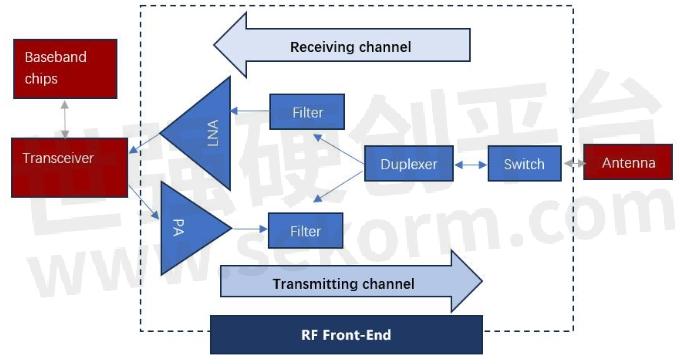How Does the 5G RF Front-end Play an Important Role?

The RF front-end is a vital PArt of wireless communication equipment, and it is the basic component for converting wireless electromagnetic wave signals and binary digital signals into each other.

The Structure of the RF Front-End
RF front-ends can be divided into transmitter (TX) and receiver (RX) based on function.
According to the components, it can be divided into power amplifiers (PA), low-frequency noise amplifiers (LNAs), filters, switches, duplexers, and tuners (Antenna Tuner).
a) The power amplifier is responsible for the RF signal amplification of the transmitting channel to ensure that the signal can reach the effective transmission distance.
b) The filter is responsible for the filtering of the transmitted and received signals, removing unwanted frequency bands and spurious signals, and improving the signal quality.
c) The low noise amplifier is responsible for the small signal amplification in the receiving channel to ensure the reliability and sensitivity of the signal.
d) The RF switch is responsible for switching between the receiving and transmitting channels to ensure the correct transmission path of the signal.
e) The duplexer is responsible for quasi-duplex switching and filters the RF signals of the receiving and transmitting channels to avoid mutual interference at the same time.
f) The tuner is responsible for channel selection, frequency variation, and amplification of RF signals to suit different communication needs.
RF Front-end Challenges and Development in the 5G Era
In the 5G era, the number of signal frequency bands has increased dramatically, and the number of components required has also increased significantly, 5G communication equipment needs to be backward compatible with 4G and 3G, which increases the demand further.
According to the research data, each additional frequency band requires the addition of 1 PA, 1 duplexer, 1 switch, 1 LNA, and 2 filters. It can be seen that in the 5G era, the number of RF front-end components is growing exponentially.
To meet this challenge, RF front-ends are becoming modularized increasingly. The modular design can reduce the footprint of the PCB area and adapt to the needs of miniaturized terminals. Modularity also improves production consistency and ensures product quality and reliability. In addition, the modular design also helps to shorten the product development cycle and improve development efficiency.
As a key component of wireless communication, the RF front-end is facing huge challenges and opportunities in the 5G era. Through continuous technological innovation and modular design, the RF front-end is able to meet the growing demand for frequency bands and provide more efficient and reliable communication services.
In addition, with the rapid development of the Internet of Things, RF front-ends also play an important role in connecting a large number of IoT devices and enabling low-power WAN communication. RF front-ends need to be continuously improved and innovated to support more wireless communication standards and protocols and to provide higher transmission rates and better signal quality.
In short, as the core component of wireless communication equipment, the RF front-end will continue to play an important role in the 5G era. Through continuous technological development and innovation, the RF front-end will be able to meet the growing communication demand, bringing people a faster, more stable, and reliable wireless communication experience.
- +1 Like
- Add to Favorites
Recommend
This document is provided by Sekorm Platform for VIP exclusive service. The copyright is owned by Sekorm. Without authorization, any medias, websites or individual are not allowed to reprint. When authorizing the reprint, the link of www.sekorm.com must be indicated.


























































































































































































































































































































































































































































































































































































































































































































































































































































































































